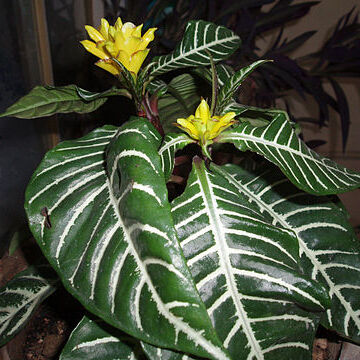Perennial suffrutescent herbs or shrubs. Stems terete to quadrangular, glabrous to pubescent, soft-wooded, nodes frequently swollen. Leaves opposite, petiolate; blades usually large, oblong to elliptic, membranous to coriaceous, marginally toothed, lobed, crenate, undulate or entire. Inflorescences of terminal or axillary spikes, solitary to few, often conspicuous with showy bracts and flowers; bracts usually imbricate, brightly colored or green, marginally toothed or entire, sometimes bearing dorsal clusters of submarginal glands; bracteoles 2, laterally subtending calyx, usually subfalcate. Flowers nearly regular to strongly bilipped, homostylous; calyx 5-lobed, lobes subequal, lanceolate, posterior (adaxial) lobe, anterior (abaxial) pair, and lateral pair of unequal width; corolla straight or curved, limb usually bilipped, pale to bright red, crimson, scarlet or orange, upper lip (posterior) erect, 2-lobed (lobes sometimes partially or completely united), lower lip (anterior) reflexed or spreading, 3-lobed, lobes subequal to strongly dimorphic with lateral ones reduced to essentially lacking; stamens 4, usually exserted but rarely if ever exceeding upper corolla lip, anthers narrow, 1-thecous, often dorsally pilose and adhering at apices by intertwining trichomes; pollen usually ellipsoidal, 3-aperturate, with exine sculpturing usually reticulate to occasionally verrucose or psilate; staminode usually none, if present, consisting of slender short filament or small callous region; ovary with 2 ovules per locule, style, frequently extending through and slightly exceeding the posterior pair of anthers. Capsules clavate to subglobose, explosively dehiscent on drying; seeds 4, brown, rounded to somewhat angled and strongly flattened to subglobose, each supported by a curved retinaculum.
More
bracts most often imbricate, some species bearing dorsal clusters of submarginal glands which may be conspicuous, the margins of the bracts entire, toothed or ciliate; bractlets various, rudimentary in a few species. Flowers with 5-merous calyx, the segments separate nearly to the base, frequently lanceolate and striate veined, the posterior segment usually broader than the others; corolla straight or curved, the limb usually bilabiate, the upper lip erect, bilobed or entire, the lower lip reflexed or spreading, 3-lobed, the middle lobe often larger than the laterals; stamens 4, usually exserted, but usually not beyond the upper lip of the corolla, the anthers narrow, 1-celled, often pilose dorsally and held together at the apices by the intertwining hairs; capsules usually clavate, 4-seeded.
Shrubs or suffrutescent herbs. Leaves opposite; blades usually large, oblong to elliptic, the margins toothed, lobed, crenate or entire. Inflorescences of terminal or axillary spikes, the spikes often conspicuous with showy bracts and flowers;

